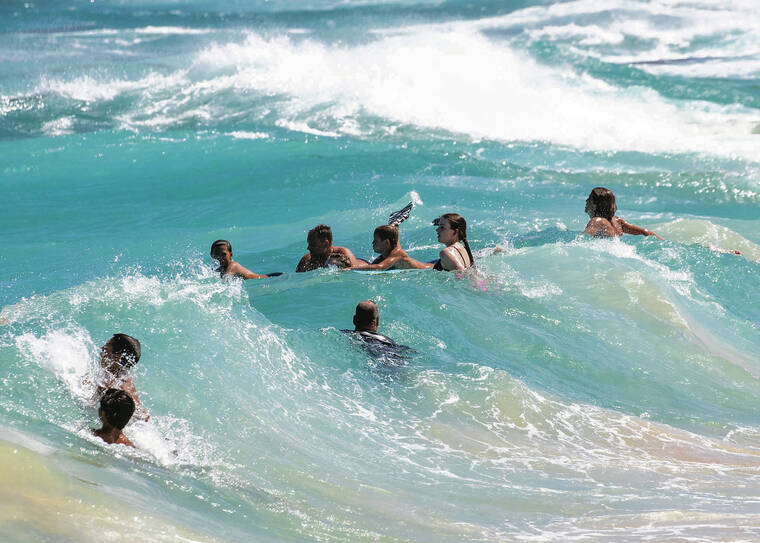
Mahalo for supporting Honolulu Star-Advertiser. Enjoy this free story!
Honolulu lifeguards are responding to swimmers in distress in more places than they used to — and at more remote beaches — than in past years as visitors return to the isles.
Ocean Safety Chief John Titchen says with the increasing popularity of social media, more visitors are going to more remote beaches, many of which have no lifeguard towers, and ending up in spots previously lesser-known.
Kahe Point, known more popularly as “Electric Beach” in Nanakuli, and the site of a recent tragedy, is one example, but other places include Shark’s Cove and Three Tables on Oahu’s North Shore, China Walls in East Honolulu and Kalama Beach along the Kailua Bay shoreline.
“There are a lot of hot spots around the island where we see increased number of visitors because of social media,” Titchen said. “Spots that were exclusively left for those in the know now are more readily available for people who can go on Instagram to find details on how to get somewhere.”
A growing number of rescues also take place at Ko Olina, Kahana Bay and Kaena Point — and at offshore islets such as the Mokuluas off Kailua.
Spotting this trend years ago, Titchen said Ocean Safety increased its mobile response units to patrol hot spots, but will also add more lifeguard towers.
The top three rescue hot spots on Oahu, however, have remained consistent over the years.
Sandy Beach Park is the No. 1 rescue spot, with an average of 800 rescues per year; followed by Waikiki, at No. 2, with an average of 500 rescues per year; and Hanauma Bay Nature Preserve, at No. 3, with an average of 300 rescues per year over the past three years.
Honolulu Ocean Safety is the city’s primary responder for emergencies on the beaches, covering more than 200 miles of shoreline and near-shore waters out to a mile off Oahu.
Titchen said Ocean Safety partners effectively with Emergency Medical Services, fire and police to respond to 911 calls on beaches.
“We cannot be everywhere at once, so we remind the public to call 911 and lifeguards will be dispatched for any incident near the beach,” he said.
Drowning among visitors
Drowning is the fifth leading cause of fatal injuries among Hawaii residents, according to data from the state Department of Health, behind all types of traffic-related injuries combined, with an average of 48 per year.
However, drowning is by far the leading cause of fatalities among visitors, mostly in the ocean.
From 2013 to 2022 there were 792 total fatal ocean drownings, according to preliminary data from DOH — 54% visitors compared with 46% residents.
In 2020, when travel was restricted, total drownings dipped to 56, well below the average of 79 for those 10 years. As more visitors return to Hawaii without COVID-19 restrictions, the number of drownings is also rising again.
“The fact it’s trending back up again in concert with visitors returning is what we would expect, unfortunately,” said Dan Galanis, epidemiologist with the DOH’s Injury Prevention and Control Section.
The majority of drownings over the years, 84%, occurred in oceans, while about 8% occurred in swimming pools.
Snorkeling remains the leading activity among ocean drownings. From 2013 to 2022 nearly 30% of ocean drownings occurred during swimming, and 21% while swimming.
At the same time, Galanis said, snorkeling is increasing in popularity, and this may be because it’s less expensive, more accessible and perceived as easy.
Snorkeling, however, is a strenuous activity — and breathing with snorkel equipment can be more challenging than swimming, particularly for those with certain underlying health conditions.
A state brochure tackles the myth that one can snorkel without knowing how to swim. Anyone who intends to go snorkeling in Hawaii should be an experienced ocean swimmer, it said, familiar with the risks of high surf, strong currents and waves breaking in shallow water.
Educating visitors
Lifeguards proactively take preventive actions by reaching out to visitors to warn them of the dangers at Sandy Beach Park, aka Sandy’s in Hawaii Kai, which is best for experts only due to the powerful shorebreak.
Sandy’s is also featured prominently on social media, so many visitors — some of them spilling over from Hanauma Bay — end up there, looking for another spot to snorkel.
“Our messages remain consistent: Sandy’s is not a beach for first-time ocean users,” Titchen said. “Even on a small day, it’s experts-only because of the hazards with the shore break and the current.”
Titchen said the demographics now has shifted, with more visitors from the mainland than international visitors. Rescues at Hanauma Bay have decreased, he said, since the reservation system was put in place, limiting the number of visitors.
But places like Electric Beach seem to be getting more calls as more visitors — and locals — flock to it. In 2022 there were 35 emergency calls involving drownings, near drownings or major injuries there, compared with just five in 2013.
There, he said, it is easy to get pushed out by the wind, particularly if one is facedown looking for fish, and to end up farther offshore than planned.
A new lifeguard tower — Oahu’s 42nd — has been budgeted for Kahe Point after advocacy from the local neighborhood board and City Council member Andria Tupola.
It should be installed by the end of the year, Titchen said. A new lifeguard tower is also expected for Kalama Beach in Kailua, but not this year.
Patty Kahanamoku-Teruya, chair of the Nanakuli-Maili Neighborhood Board, said it had been advocating for the lifeguard tower since at least 2019. She welcomes the new tower as soon as possible and hopes it will be staffed.
She said Electric Beach has gotten more popular with visitors as tour companies bring groups to train for diving and snorkeling excursions. Due to its proximity to Ko Olina, it has become a popular alternative when parking is unavailable at the resort beaches.
The board noticed the situation along the Waianae coastline — from Tracks to Kahe Point — was getting more dangerous and that there was no lifeguard tower.
A lifeguard presence means warning signs will be posted, she said, with preventive actions, and rescues can be made much more quickly.
“There needs to be education of we’re an island, we’re surrounding by rough ocean,” she said. “Everyone loves the beauty of Hawaii, but there are areas that are dangerous. … If they’re staying in a hotel, they should have information, even the planes.”
She was saddened by the recent drowning of a man from California who was on his honeymoon with his wife, at Electric Beach, compounded by the theft of their backpack and rental car. But that was not the first drowning incident or theft in the area, she said.
Prevention
While the circumstances of each drowning incident might differ, the tragedy of the loss is devastating. The question is how to prevent them.
Galanis said partnering with travel agencies on education campaigns is important but expensive, with the challenge of reaching a transitory audience.
In the past, DOH and the city have made efforts, with public service announcements.
In 2017 the city partnered with Real Hawaii TV to air 25-second PSAs in 25,000 hotel rooms on Oahu. Some PSAs also played at the airport, but stopped after funds ran dry.
A subcommittee conducted an extensive snorkel safety study — funded by the Hawaii Tourism Authority — examining causes and risk factors for snorkel-related drownings.
It looked at whether the type of snorkeling equipment — traditional versus full-face masks — plays a role, along with hypoxia from rapid onset pulmonary edema, and prolonged air travel. It examined autopsy reports, surveyed survivors and determined that more studies are needed.
Titchen said it is important to be aware that the ocean around Hawaii is not the same as elsewhere.
“Even when it looks calm, it may be treacherous,” he said. “What’s happening under the water can be a factor — reefs and shelves and bays and a lot of dynamic activity people may be unaware of. It’s dramatically different than some other parts of the world.”
STATE DROWNING STATISTICS
From 2013 to 2022 there were 792 fatal ocean drownings in Hawaii.*
>> Of the total, 54% were visitors, 46% residents.
>> The highest number, 93, occurred pre-pandemic, in 2019. The lowest, 56, occurred in 2020, when the number of visitors dropped due to COVID-19 restrictions.
>> Nearly 30% (229) of ocean drownings occurred while snorkeling, 21% (165) while swimming, 7% (58) while surfing or bodyboarding.
>> Most drownings, 84%, occur in the ocean, 8% in swimming pools, the remainder in freshwater bodies such as streams and bathtubs.
* Data for 2022 is preliminary.
OCEAN SAFETY TIPS
>> Understand and observe beach warning signs regarding dangerous shore breaks or strong currents.
>> Know your body’s limits. Know how to swim.
>> Swim near a lifeguard. Check with the lifeguard about current conditions and safety hazards before going in the ocean.
>> Swim with a buddy or, at the very least, have someone on shore watching you.
>> Swim during daylight hours.
>> Learn how to use equipment properly before entering the water. Never use a snorkel in the water if you are uncomfortable with it outside of the water.
>> Be aware that ocean currents and wind can quickly carry inner tubes and floaties away from shore, taking you with them.
>> Stay sober before and while participating in ocean activities.
>> Stay calm. If you need help, do not panic and get a lifeguard’s attention (raise your arms and wave side to side).
MORE INFORMATION
Visit oceansafety.hawaii.gov for more tips.
Read More: World News | Entertainment News | Celeb News
Star








